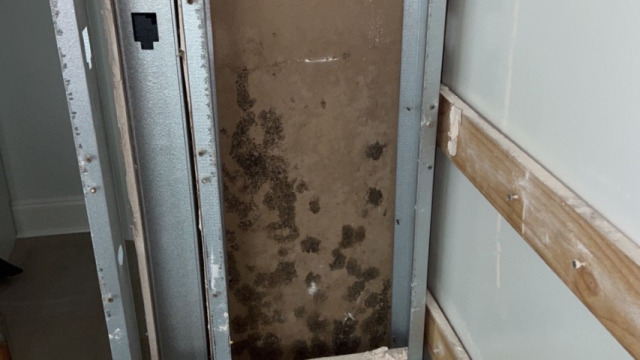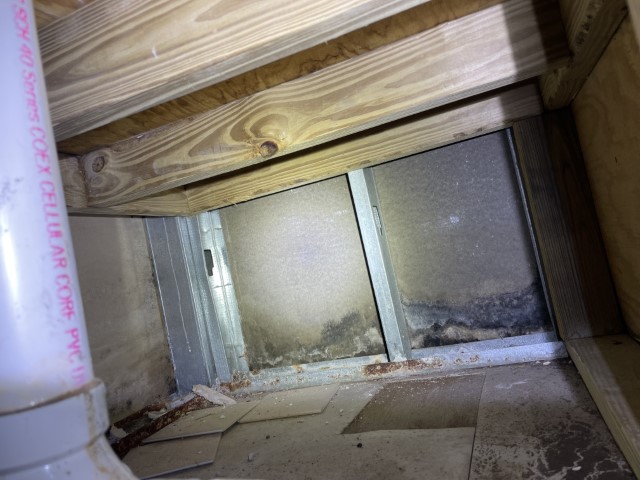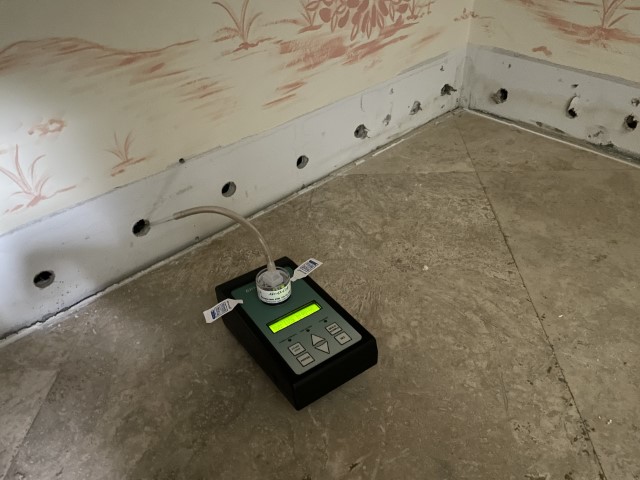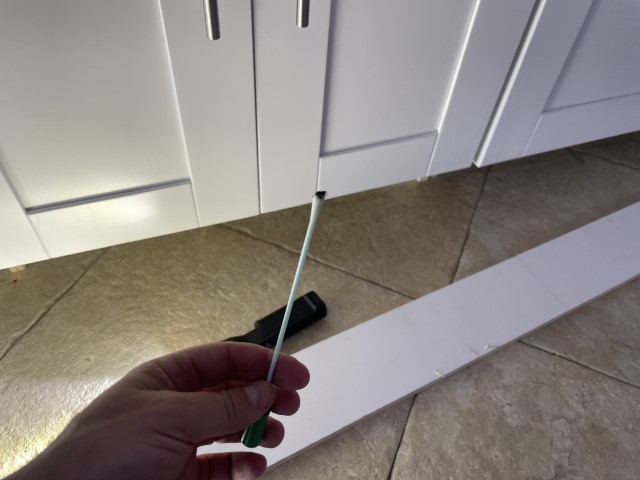Professional Mold Remediation Services
Don't Let Toxic Mold Put Your Family's Health at Risk
Stop mold damage before it spreads. Call now for a free, no-obligation estimate from a local remediation expert.
Free Estimate · Zero Obligation · Available 24/7
How to Know if Mold Is in Your Walls
Having mold along your walls is easy for anybody to detect.
But what is not easy is finding hidden mold inside your walls.
Many things can leak within your walls that can cause mold growth such as:
- Leaking pipes
- Roof Leaks that trickle down
- HVAC ductwork leaks
- Positive Air pressure inside walls
- Window leaks
- Poor Ventilation
Detecting mold inside the wall cavity is difficult but not impossible when there is no visible mold present. In this article, we will go over the method on how to find mold inside walls.
Why Mold Grows Inside Walls
Hidden mold inside walls is the result of one thing:
Water.
Above are a few of the causes of mold growth inside your walls but why exactly do these leak issues lead to mold?
You see:
Mold loves dark/moist places and what is more dark and moist than inside walls?
The problem is that you are not always going to be able to see moisture inside walls. Most people expect that if a wall is wet and they touch it, they should be able to feel the moisture and that’s just simply not the case.
A moisture meter will typically be needed to find moisture. Most people will obviously not have moisture meters and will not know where to look (more on that later).
By the time somebody realizes they have a leak, often it’s too late. The leak has been going on for a long period of time and the walls are completely saturated.

Mold can start to grow within 24-48 hours of the initial water damage.
Walls may also have insulation present. And while the wet insulation will absorb some of the water, it will also enable to closed-in space to retain moisture because the insulation will not dry out without some kind of forced mechanical action such as a fan or dehumidifier.
Mold spores present within the walls will start to colonize and all of a sudden you have a mold problem.
Is Mold Inside Walls Dangerous?
Whether mold is inside walls or out in the open it can certainly be dangerous if it’s producing mycotoxins that become airborne.

Just because mold is present behind the walls does not mean it will always be airborne. Sampling may need to be done to determine what type of mold is present, but more on that in a bit.
So is mold inside walls dangerous? it’s a case-by-case basis but it could be.
How To Detect Mold Inside Walls
In order to identify mold in walls, there are a few tell-tale signs that could signal a mold infestation.
Musty Odor
Mold has a distinct musty smell that many people will compare to a locker room or dirty socks.
If ever been in an unfinished basement it may have that moist/earthy smell. If you are smelling an odd odor in a particular room, it could indicate either a wet wall or mold growing inside of a wall.
Visual Signs of Water Damage
Visible stains can be present on the outside of the walls which could indicate mold inside the walls.
Now, just because you have a water stain doesn’t automatically mean there will be mold in the walls, but it’s certainly a possibility.
Checking the ceiling and closet walls which are often neglected for water stains is crucial. If you are seeing a brownish or yellowish stain along a ceiling it could mean there is a roof leak. Mold spores can then attach to the wet building materials and all of a sudden there is mold damage.
Baseboards and Crown Molding
As a mold inspector, the most crucial way for me to find mold inside walls is by paying attention to the baseboards and crown molding.
When wood (which is what most base molding is made of) gets wet, it expands and as a result, it gets heavier. The molding will then start pulling away from the ceiling or wall which can indicate water intrusion.
Testing Moisture Content on Building Materials
Since we know water leads to a mold issue hidden in walls, if you can somehow test for water damage it can be your smoking gun for finding mold.
Oh, wait… You can!
It’s called a moisture meter.
A moisture meter works when it sends an electrical current through the building materials that are being tested for moisture. The resistance of the current is what is used to determine the moisture content percentage. There are no threshold limits, however when talking about walls, usually, anything above approximately 18% is considered actively wet.
Thermal imaging cameras can also be used to detect temperature differentials which could indicate mold growth.
Wall Cavity Samples
While performing moisture mapping can often lead to finding mold inside walls, there is no guarantee that microbial growth will be present.
There are only two ways to confirm mold in walls:
- Removing the walls
- Testing For Mold Inside the walls

While an ambient air sample can test for mold spores that may become airborne in the living air, a particular type of mold test is specifically designed to find mold behind wall coverings.
This type of test is commonly referred to in the mold industry as inner wall sampling. While this type of sampling can detect mold in walls, it’s not without controversy.
Inner wall testing for mold involves drilling a hole (approximately 1/4 inch diameter) into the wall using a hand drill. A tube is then connected to an air sample cassette on a negative air pump. Air is taken from behind the wall of the tube and collected on a sticky substance in the middle of the air cassette.
Many professionals within the mold industry argue that destruction to the wall prior to sampling is not good for the accuracy of the mold conditions behind drywall.
In the book Field Guide for the Determination of Biological Containments in Environmental Samples 2nd Edition by The American Industrial Hygiene Association, the Authors say this about wall cavity testing for mold:
“air samples collected from within a wall cavity when the wallboard is aggressively disturbed ( e.g. by drilling or pounding) hardly represents normal bioaerosol exposure of room occupants and can result in possible false positive results.”
While some professionals don’t recommend putting holes in drywall, there are some ways around it.
Outlet covers that have access to wall cavities such as electrical outlets or cable outlets can be taken off the test behind the wall. While this is not always feasible, it is a much better option than destructive wall testing. Sometimes you can also see visible mold when the plate cover is removed
While air sampling in the ambient air space is typically done for 5-10 minutes to collect 75 or 150 liters of air, wall cavity sampling should be done for the top 1 minute collecting 15 liters of air.
Once the mold samples are taken, the samples are then sent off to a laboratory for analysis. A lab report will indicate how much mold and what type is present. There is to be some mold expected in a wall space, but there are certain types of mold you just don’t want to see.
For example, you hear about “black mold” well that type of mold refers to a particular species of mold called Stachbotrys. Black mold is a slow-growing mold that can produce mycotoxins. Mold removal is necessary if this type of mold is found in the wall cavity.
Swab or Tape Samples
Mold testing inside walls is not just limited to air samples. Tape or swab samples can be taken which is done exactly how you would think.
A cotton swab or tape medium will go right on the surface where mold is suspected.

Now:
It’s not always possible to get a direct sample with the swab or tape behind a wall. In some cases, it can be accessed by a wall plate but another way it can be done is by pealing back the baseboards. Once visible mold is revealed, the sample can be taken.
Attic and Crawl Space
The backside of the walls can also sometimes be seen in either the attic above the living space or the crawl space under the living space.
Insulation may get in the way but sometimes there are penetration holes present under the air conditioner or around plumbing stacks when it’s in the attic.
Does Mold Inside Walls Need To Be Removed?
A growing fad in some parts of the United States is leaving mold dormant behind the walls and going through a process called dry fogging. The theory behind that is that the mold is dormant behind the walls and it will not affect one’s health. Do you really want to leave black mold or any other mold for that matter inside your walls? The answer is no. You will want to remove mold if you know it’s present.
The issue with that is that it doesn’t matter if you kill mold. Dead mold has been known to be as much of a hazard as living mold. Mold removal should be done based on The Institute of Inspection Cleaning and Restoration Certification. Source
In order to remove mold inside walls, a process called mold remediation will need to be performed. It involves setting up plastic containment barriers that prevent mold from spreading throughout the indoor air within the home.
Removing mold has to be done in a methodical way.
Anytime mold is suspected in an area exceeding 10 square feet, the EPA recommends it be done by a licensed mold professional and should never be done without proper PPE.
Prevent Mold Inside Walls- Is it Possible?
It is possible to prevent mold growth within walls and it starts by controlling moisture.
Now obviously if a leak occurs, it’s not always possible to stop walls from getting wet.
However, being proactive once a leak is found to dry out a water-damaged area can be the difference between a large mold issue and not a mold issue. If an area does not properly dry in time, it may be necessary to remove mold.
Emergency dry-out should be done by professionals because there are techniques that can make the drying-out process quicker and time is of the essence.
Here are a few ways mold within walls can be dried out:
Fans
Large fans also referred to as air movers can be used to dry out inner walls. Little holes approximately 1/2 inch should be made along the bottom of the walls behind baseboards to dry out the wall cavity space.
If visible mold is already present fans should not be used.
Dehumidifiers
Dehumidifiers can help remove water content from building materials. The big commercial ones can be very powerful.
Explore Related Topics:
Notice an update we should make?
We strive for accuracy. Contact us here if you see incorrect or outdated info on this page.

